A Systematic Review of Energy Management Strategies for Resource Allocation in the Cloud: Clustering, Optimization and Machine Learning
Abstract
:1. Introduction
- This paper reviews the recent methods in the clustering, optimization and machine learning in energy management for resource allocation in the cloud. Various models’ advantage and limitations in cloud environment are discussed.
- Various optimization models applied in existing cloud for energy management and their limitations are reviewed. The review shows that most of the optimization models suffer from local optima and poor convergence.
- This paper focuses not only on energy consumption, but also on SLA violation and QoS, simultaneously. The review shows that multi-objective optimization models handles the better tradeoff in the output parameters.
- A review of machine learning models shows that DNN often provides the higher prediction performance and thus, it has the capability of predicting risk of high energy consumption.
- Limitations in the existing methods are discussed in this study. Furthermore, this review provides the potential solution to overcome such limitations in the cloud energy management.
2. Applications of Energy Consumption in Cloud Data Centers
- Streaming services like Netflix, Amazon Prime etc., are providing users with flexible streaming and QoS. Streaming services require the optimization method to provide the optimal parameter settings such as resource allocation, bandwidth limit etc., to provide effective performance and reduce energy consumption [8]. Machine learning methods are required in the streaming services to provide the effective resource allocation to fulfill high demand, and high energy consumption in the cloud.
- Large companies such as Amazon, Microsoft, Facebook and Google are deploying their cloud for the public cloud infrastructure [2]. Optimization methods are applied in this cloud to handle the energy consumption and demand.
- Diverse works [5,10] show that cloud services such as Amazon Web Services (AWS) Elastic Compute cloud (EC2), Microsoft’s Photo Gallery face recognition, Facebook automatic face tagging, Google glass object recognition, and Google Goggles required an energy optimization model to improve the performance.
- Furthermore, machine learning methods are applied in the cloud services for the detection of attacks such as distributed denial of services (DDoS), and blocking the victim infrastructure, to protect the users [2].
- The Internet of Things (IoT) is one of the fastest developing fields and highly adaptive in many industries for monitoring and control [3,5]. IoT stores and processes the data in cloud computing to provide excellent performance. Energy optimization in cloud-IoT is required in the industry to provide ideal performance and profit [3].
- Generally, cloud computing provides three types of service known as software as a service (SaaS), platform as a service (PaaS), and infrastructure as a service (IaaS) [4,6]. Optimization methods are required in all these three types of services for the resource allocation, energy consumption and SLA violation.
3. Review of Energy Consumption in Cloud Data Centers
- Clustering techniques are mainly applied to select the cluster head or similar types of workload to effectively apply the resources to the users. The clustering method recognizes a similar group of workloads and analyses the resource availability for the resource allocation.
- Optimization methods involve in the analysis of the network parameters such as CPU, RAM and disk availability related to the energy consumption and SLA for the allocation. Optimization methods are used as an attempt to find the solution for the allocation based on objective rather than similar types of workload.
- Machine learning methods involve identifying the risk factors such as high energy consumption or high SLA violation based on the historical data. These prediction results were used to avoid the high energy consumption and high SLA violation in the cloud resource allocation.
3.1. Static and Dynamic Energy Model
- Static Power Consumption
- Dynamic Power Consumption
3.2. Energy Consumption
3.3. Service Level Agreement (SLA) Violation
3.4. Clustering Method in Energy Management
3.5. Energy Optimization in the Cloud
3.6. Machine Learning Methods in Energy Management
3.7. Virtual Machine (VM) Migration for Energy Consumption
4. Comparative Analysis
5. Summary of Challenges from Reviewed Studies
- Most studies consider the energy consumption and QoS as the parameters to analyze the energy efficiency in resource allocation. The SLA violation, reliability and makespan are also need to be considered in the methods for effective cloud performance.
- Clustering methods are applied in the existing research to choose the cluster nodes and perform resource allocation. The random initialization in the clustering method affects the performance of the cluster model.
- Evolutionary optimization methods like WOA, PSO, GA, and the firefly algorithm have efficient performance in energy management. Existing optimization methods have the limitations of lower convergences and easily trap local optima.
- The SVM and random forest methods are applied for the prediction of energy consumption in the cloud and allocate the resource to improve the energy efficiency. The SVM method has the lowest performance in the data imbalance problem. Random forest has overfitting problems when the number of trees is high in the model and has lower performance when number of trees is low.
- The DNN model has the highest performance in the prediction of energy consumption in the cloud data center. The DNN model has the limitation of the overfitting problem due to the feature process in the model.
6. Future Scope
- Multi-objective optimization methods are needed to handle the energy consumption, QoS and SLA violation. NSGA-II has provided higher performance in multi-objective optimization and poor convergence. Multi-objective methods with high convergence are needed to improve the efficiency of the model.
- The k-means clustering proper initialization needs to be provided to achieve higher performance in cluster the workloads in the various scenarios of the cloud. The k-means clustering random initialization does not guarantee the best solution in various scenarios.
- DNN with effective feature selection technique needs to be applied to improve the efficiency of the model and to overcome the limitation of overfitting problem. DNN has the overfitting problem that affects its performance.
- Apart from the DNN, long short-term memory (LSTM) delivers efficient performance in handling the sequence of data and provides efficient classification. The LSTM has a higher potential in prediction of energy consumption and SLA violation.
- Time efficiency is one of the important factors that most of the existing researches did not consider in the analysis. Time efficiency in the cloud technology must be maintained to facilitate smooth operations of the real-time cloud systems to get an edge over the competitors.
7. Conclusions
Author Contributions
Funding
Institutional Review Board Statement
Informed Consent Statement
Data Availability Statement
Conflicts of Interest
References
- Moganarangan, N.; Babukarthik, R.G.; Bhuvaneswari, S.; Basha, M.S.; Dhavachelvan, P. A novel algorithm for reducing energy-consumption in Cloud computing environment: Web service computing approach. J. King Saud Univ. -Comput. Inf. Sci. 2016, 28, 55–67. [Google Scholar] [CrossRef] [Green Version]
- Ficco, M.; Palmieri, F. Introducing fraudulent energy consumption in Cloud infrastructures: A new generation of denial-of-service attacks. IEEE Syst. J. 2015, 11, 460–470. [Google Scholar] [CrossRef]
- Ahvar, E.; Orgerie, A.C.; Lebre, A. Estimating energy consumption of Cloud, fog and edge computing infrastructures. IEEE Trans. Sustain. Comput. 2019. [Google Scholar] [CrossRef] [Green Version]
- El Kafhali, S.; Salah, K. Modeling and analysis of performance and energy consumption in Cloud data centers. Arab. J. Sci. Eng. 2018, 43, 7789–7802. [Google Scholar] [CrossRef]
- Renna, F.; Doyle, J.; Giotsas, V.; Andreopoulos, Y. Media query processing for the Internet-of-Things: Coupling of device energy consumption and Cloud infrastructure billing. IEEE Trans. Multimed. 2016, 18, 2537–2552. [Google Scholar] [CrossRef] [Green Version]
- Vishwanath, A.; Jalali, F.; Hinton, K.; Alpcan, T.; Ayre, R.W.; Tucker, R.S. Energy consumption comparison of interactive Cloud-based and local applications. IEEE J. Sel. Areas Commun. 2015, 33, 616–626. [Google Scholar] [CrossRef]
- Ibrahim, H.; Aburukba, R.O.; El-Fakih, K. An integer linear programming model and adaptive genetic algorithm approach to minimize energy consumption of Cloud computing data centers. Comput. Electr. Eng. 2018, 67, 551–565. [Google Scholar] [CrossRef]
- Shen, Y.; Bao, Z.; Qin, X.; Shen, J. Adaptive task scheduling strategy in Cloud: When energy consumption meets performance guarantee. World Wide Web 2017, 20, 155–173. [Google Scholar] [CrossRef]
- Shaw, S.B.; Singh, A.K. Use of proactive and reactive hotspot detection technique to reduce the number of virtual machine migration and energy consumption in Cloud data center. Comput. Electr. Eng. 2015, 47, 241–254. [Google Scholar] [CrossRef]
- Khomh, F.; Abtahizadeh, S.A. Understanding the impact of Cloud patterns on performance and energy consumption. J. Syst. Softw. 2018, 141, 151–170. [Google Scholar] [CrossRef]
- Hasan, M.S.; Alvares, F.; Ledoux, T.; Pazat, J.L. Investigating energy consumption and performance trade-off for interactive Cloud application. IEEE Trans. Sustain. Comput. 2017, 2, 113–126. [Google Scholar] [CrossRef]
- Abd, S.K.; Al-Haddad, S.A.R.; Hashim, F.; Abdullah, A.B.; Yussof, S. An effective approach for managing power consumption in Cloud computing infrastructure. J. Comput. Sci. 2017, 21, 349–360. [Google Scholar] [CrossRef]
- Hanini, M.; Kafhali, S.E.; Salah, K. Dynamic VM allocation and traffic control to manage QoS and energy consumption in Cloud computing environment. Int. J. Comput. Appl. Technol. 2019, 60, 307–316. [Google Scholar] [CrossRef]
- Xiong, A.P.; Xu, C.X. Energy efficient multiresource allocation of virtual machine based on PSO in Cloud data center. Math. Probl. Eng. 2014. [Google Scholar] [CrossRef]
- Horri, A.; Dastghaibyfard, G. A novel cost based model for energy consumption in Cloud computing. Sci. World J. 2015. [Google Scholar] [CrossRef] [PubMed] [Green Version]
- Soltanshahi, M.; Asemi, R.; Shafiei, N. Energy-aware virtual machines allocation by krill herd algorithm in Cloud data centers. Heliyon 2019, 5, e02066. [Google Scholar] [CrossRef] [PubMed]
- Simic, V.; Stojanovic, B.; Ivanovic, M. Optimizing the performance of optimization in the Cloud environment–An intelligent auto-scaling approach. Future Gener. Comput. Syst. 2019, 101, 909–920. [Google Scholar] [CrossRef]
- Arianyan, E.; Taheri, H.; Khoshdel, V. Novel fuzzy multi objective DVFS-aware consolidation heuristics for energy and SLA efficient resource management in Cloud data centers. J. Netw. Comput. Appl. 2017, 78, 43–61. [Google Scholar] [CrossRef]
- Prassanna, J.; Venkataraman, N. Adaptive regressive holt–winters workload prediction and firefly optimized lottery scheduling for load balancing in Cloud. Wirel. Netw. 2019, 1–19. [Google Scholar] [CrossRef]
- Vasudevan, M.; Tian, Y.C.; Tang, M.; Kozan, E.; Zhang, X. Energy-efficient application assignment in profile-based data center management through a Repairing Genetic Algorithm. Appl. Soft Comput. 2018, 67, 399–408. [Google Scholar] [CrossRef] [Green Version]
- Gill, S.S.; Buyya, R. Resource provisioning based scheduling framework for execution of heterogeneous and clustered workloads in clouds: From fundamental to autonomic offering. J. Grid Comput. 2019, 17, 385–417. [Google Scholar] [CrossRef]
- Shahidinejad, A.; Ghobaei-Arani, M.; Masdari, M. Resource provisioning using workload clustering in Cloud computing environment: A hybrid approach. Clust. Comput. 2021, 24, 319–342. [Google Scholar] [CrossRef]
- Haghighi, M.A.; Maeen, M.; Haghparast, M. An energy-efficient dynamic resource management approach based on clustering and meta-heuristic algorithms in Cloud computing IaaS platforms. Wirel. Pers. Commun. 2019, 104, 1367–1391. [Google Scholar] [CrossRef]
- Mydhili, S.K.; Periyanayagi, S.; Baskar, S.; Shakeel, P.M.; Hariharan, P.R. Machine learning based multi scale parallel K-means++ clustering for Cloud assisted internet of things. Peer-to-Peer Netw. Appl. 2020, 13, 2023–2035. [Google Scholar] [CrossRef]
- Haseeb, K.; Almogren, A.; Ud Din, I.; Islam, N.; Altameem, A. Sasc: Secure and authentication-based sensor Cloud architecture for intelligent internet of things. Sensors 2020, 20, 2468. [Google Scholar] [CrossRef]
- Alarifi, A.; Tolba, A. Optimizing the network energy of Cloud assisted internet of things by using the adaptive neural learning approach in wireless sensor networks. Comput. Ind. 2019, 106, 133–141. [Google Scholar] [CrossRef]
- RM, S.P.; Bhattacharya, S.; Maddikunta, P.K.R.; Somayaji, S.R.K.; Lakshmanna, K.; Kaluri, R.; Hussien, A.; Gadekallu, T.R. Load balancing of energy Cloud using wind driven and firefly algorithms in internet of everything. J. Parallel Distrib. Comput. 2020, 142, 16–26. [Google Scholar]
- Peng, H.; Wen, W.S.; Tseng, M.L.; Li, L.L. Joint optimization method for task scheduling time and energy consumption in mobile Cloud computing environment. Appl. Soft Comput. 2019, 80, 534–545. [Google Scholar] [CrossRef]
- Yadav, R.; Zhang, W.; Li, K.; Liu, C.; Shafiq, M.; Karn, N.K. An adaptive heuristic for managing energy consumption and overloaded hosts in a Cloud data center. Wirel. Netw. 2020, 26, 1905–1919. [Google Scholar] [CrossRef]
- Zhou, Z.; Abawajy, J.; Chowdhury, M.; Hu, Z.; Li, K.; Cheng, H.; Alelaiwi, A.A.; Li, F. Minimizing SLA violation and power consumption in Cloud data centers using adaptive energy-aware algorithms. Future Gener. Comput. Syst. 2018, 86, 836–850. [Google Scholar] [CrossRef]
- Goyal, S.; Bhushan, S.; Kumar, Y.; Bhutta, M.R.; Ijaz, M.F.; Son, Y. An Optimized Framework for Energy-Resource Allocation in a Cloud Environment based on the Whale Optimization Algorithm. Sensors 2021, 21, 1583. [Google Scholar] [CrossRef] [PubMed]
- Manumachu, R.R.; Lastovetsky, A. Bi-objective optimization of data-parallel applications on homogeneous multicore clusters for performance and energy. IEEE Trans. Comput. 2017, 67, 160–177. [Google Scholar] [CrossRef]
- Sofia, A.S.; GaneshKumar, P. Multi-objective task scheduling to minimize energy consumption and makespan of Cloud computing using NSGA-II. J. Netw. Syst. Manag. 2018, 26, 463–485. [Google Scholar] [CrossRef]
- Azizi, S.; Li, D. An energy-efficient algorithm for virtual machine placement optimization in Cloud data centers. Clust. Comput. 2020, 23, 3421–3434. [Google Scholar] [CrossRef]
- Abohamama, A.S.; Hamouda, E. A hybrid energy–aware virtual machine placement algorithm for Cloud environments. Expert Syst. Appl. 2020, 150, 113306. [Google Scholar] [CrossRef]
- Liu, X.; Cheng, B.; Wang, S. Availability-Aware and Energy-Efficient Virtual Cluster Allocation Based on Multi-Objective Optimization in Cloud Data centers. IEEE Trans. Netw. Serv. Manag. 2018, 17, 972–985. [Google Scholar] [CrossRef]
- Saeedi, S.; Khorsand, R.; Bidgoli, S.G.; Ramezanpour, M. Improved many-objective particle swarm optimization algorithm for scientific workflow scheduling in Cloud computing. Comput. Ind. Eng. 2020, 147, 106649. [Google Scholar] [CrossRef]
- Junaid, M.; Sohail, A.; Rais, R.N.B.; Ahmed, A.; Khalid, O.; Khan, I.A.; Hussain, S.S.; Ejaz, N. Modeling an Optimized Approach for Load Balancing in Cloud. IEEE Access 2020, 8, 173208–173226. [Google Scholar] [CrossRef]
- Shapi, M.K.M.; Ramli, N.A.; Awalin, L.J. Energy consumption prediction by using machine learning for smart building: Case study in Malaysia. Dev. Built Environ. 2021, 5, 100037. [Google Scholar] [CrossRef]
- Zekić-Sušac, M.; Mitrović, S.; Has, A. Machine learning based system for managing energy efficiency of public sector as an approach towards smart cities. Int. J. Inf. Manag. 2021, 58, 102074. [Google Scholar] [CrossRef]
- Daraseliya, A.V.; Sopin, E.S.; Samuylov, A.K.; Shorgin, S.Y. Comparative analysis of the mechanisms for energy efficiency improving in cloud computing systems. In Internet of Things, Smart Spaces, and Next Generation Networks and Systems; Galinina, O., Andreev, S., Balandin, S., Koucheryavy, Y., Eds.; Springer: Cham, Switzerland, 2018; pp. 268–276. [Google Scholar]
- You, X.; Li, Y.; Zheng, M.; Zhu, C.; Yu, L. A survey and taxonomy of energy efficiency relevant surveys in cloud-related environments. IEEE Access 2017, 5, 14066–14078. [Google Scholar] [CrossRef]
- Mezmaz, M.; Melab, N.; Kessaci, Y.; Lee, Y.C.; Talbi, E.G.; Zomaya, A.Y.; Tuyttens, D. A parallel bi-objective hybrid metaheuristic for energy-aware scheduling for cloud computing systems. J. Parallel Distrib. Comput. 2011, 71, 1497–1508. [Google Scholar] [CrossRef] [Green Version]
- Fahad, M.; Shahid, A.; Manumachu, R.R.; Lastovetsky, A. A comparative study of methods for measurement of energy of computing. Energies 2019, 12, 2204. [Google Scholar] [CrossRef] [Green Version]
- Shahid, A.; Fahad, M.; Manumachu, R.R.; Lastovetsky, A. Energy Predictive Models of Computing: Theory, Practical Implications and Experimental Analysis on Multicore Processors. IEEE Access 2021, 9, 63149–63172. [Google Scholar] [CrossRef]
- Fard, S.Y.Z.; Ahmadi, M.R.; Adabi, S. A dynamic VM consolidation technique for QoS and energy consumption in Cloud environment. J. Supercomput. 2017, 73, 4347–4368. [Google Scholar]
- Aujla, G.S.; Kumar, N. MEnSuS: An efficient scheme for energy management with sustainability of Cloud data centers in edge–Cloud environment. Future Gener. Comput. Syst. 2018, 86, 1279–1300. [Google Scholar] [CrossRef]
- Karthikeyan, K.; Sunder, R.; Shankar, K.; Lakshmanaprabu, S.K.; Vijayakumar, V.; Elhoseny, M.; Manogaran, G. Energy consumption analysis of Virtual Machine migration in Cloud using hybrid swarm optimization (ABC–BA). J. Supercomput. 2020, 76, 3374–3390. [Google Scholar] [CrossRef]
- Yadav, R.; Zhang, W.; Kaiwartya, O.; Singh, P.R.; Elgendy, I.A.; Tian, Y.C. Adaptive energy-aware algorithms for minimizing energy consumption and SLA violation in Cloud computing. IEEE Access 2020, 6, 55923–55936. [Google Scholar] [CrossRef]
- Lin, W.; Wang, H.; Zhang, Y.; Qi, D.; Wang, J.Z.; Chang, V. A Cloud server energy consumption measurement system for heterogeneous Cloud environments. Inf. Sci. 2018, 468, 47–62. [Google Scholar] [CrossRef] [Green Version]
- Fernández-Cerero, D.; Fernández-Montes, A.; Jakóbik, A.; Kołodziej, J.; Toro, M. SCORE: Simulator for Cloud optimization of resources and energy consumption. Simul. Model. Pract. Theory 2018, 82, 160–173. [Google Scholar] [CrossRef]
- Chen, Y.; Xie, G.; Li, R. Reducing energy consumption with cost budget using available budget preassignment in heterogeneous Cloud computing systems. IEEE Access 2018, 6, 20572–20583. [Google Scholar] [CrossRef]
- Li, G.; Yan, J.; Chen, L.; Wu, J.; Lin, Q.; Zhang, Y. Energy consumption optimization with a delay threshold in Cloud-fog cooperation computing. IEEE Access 2019, 7, 159688–159697. [Google Scholar] [CrossRef]
- Xie, G.; Zeng, G.; Jiang, J.; Fan, C.; Li, R.; Li, K. Energy management for multiple real-time workflows on cyber–physical Cloud systems. Future Gener. Comput. Syst. 2020, 105, 916–931. [Google Scholar] [CrossRef]
- Yang, J.; Jiang, B.; Lv, Z.; Choo, K.K.R. A task scheduling algorithm considering game theory designed for energy management in Cloud computing. Future Gener. Comput. Syst. 2020, 105, 985–992. [Google Scholar] [CrossRef]
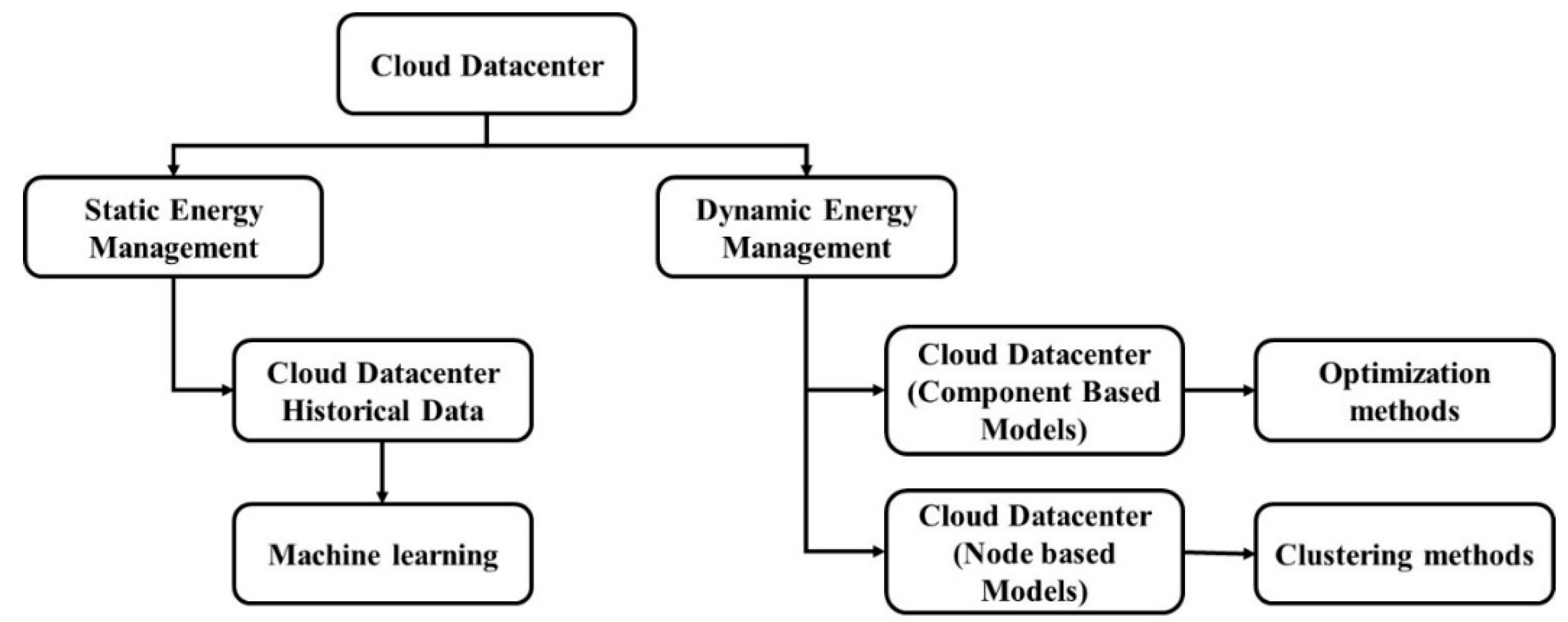
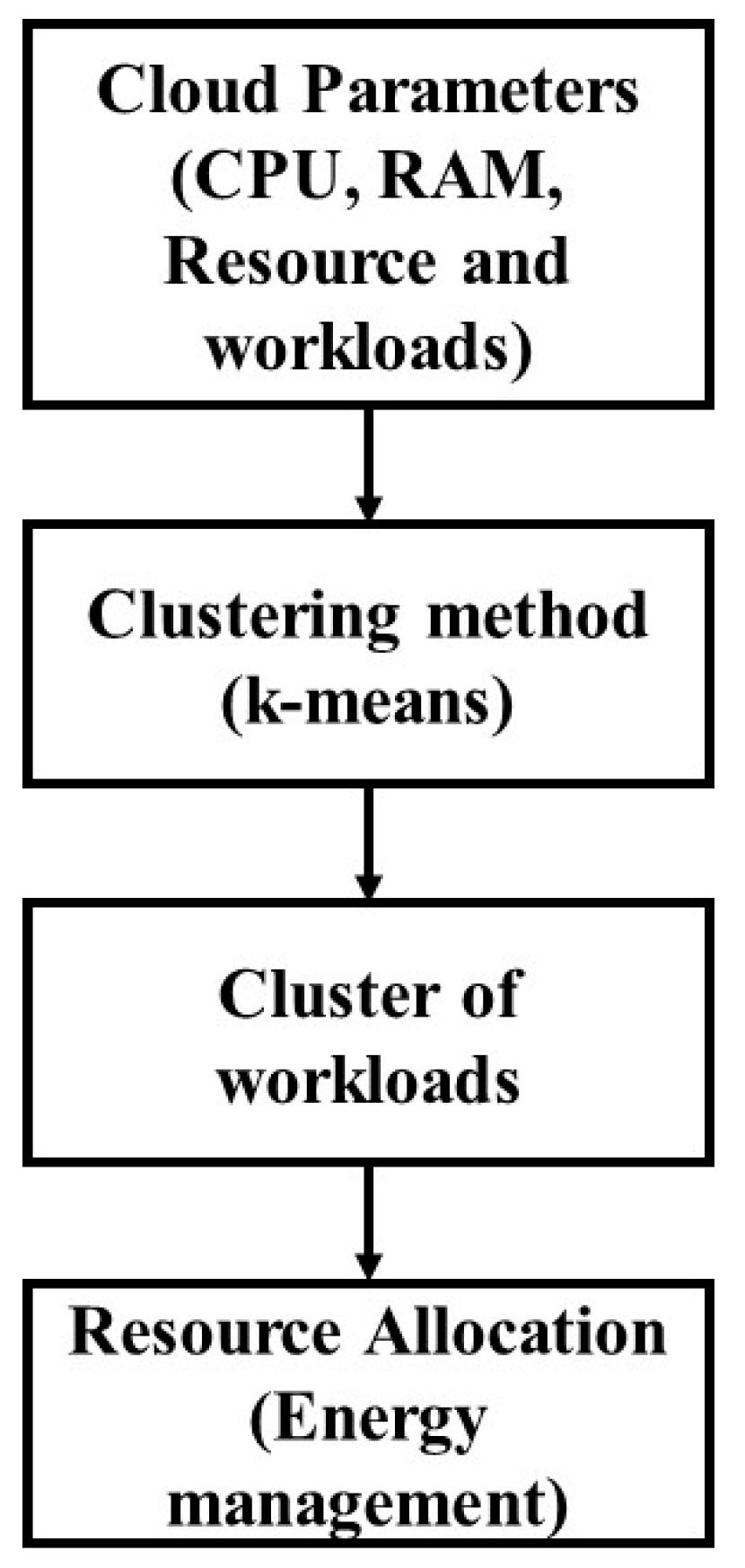

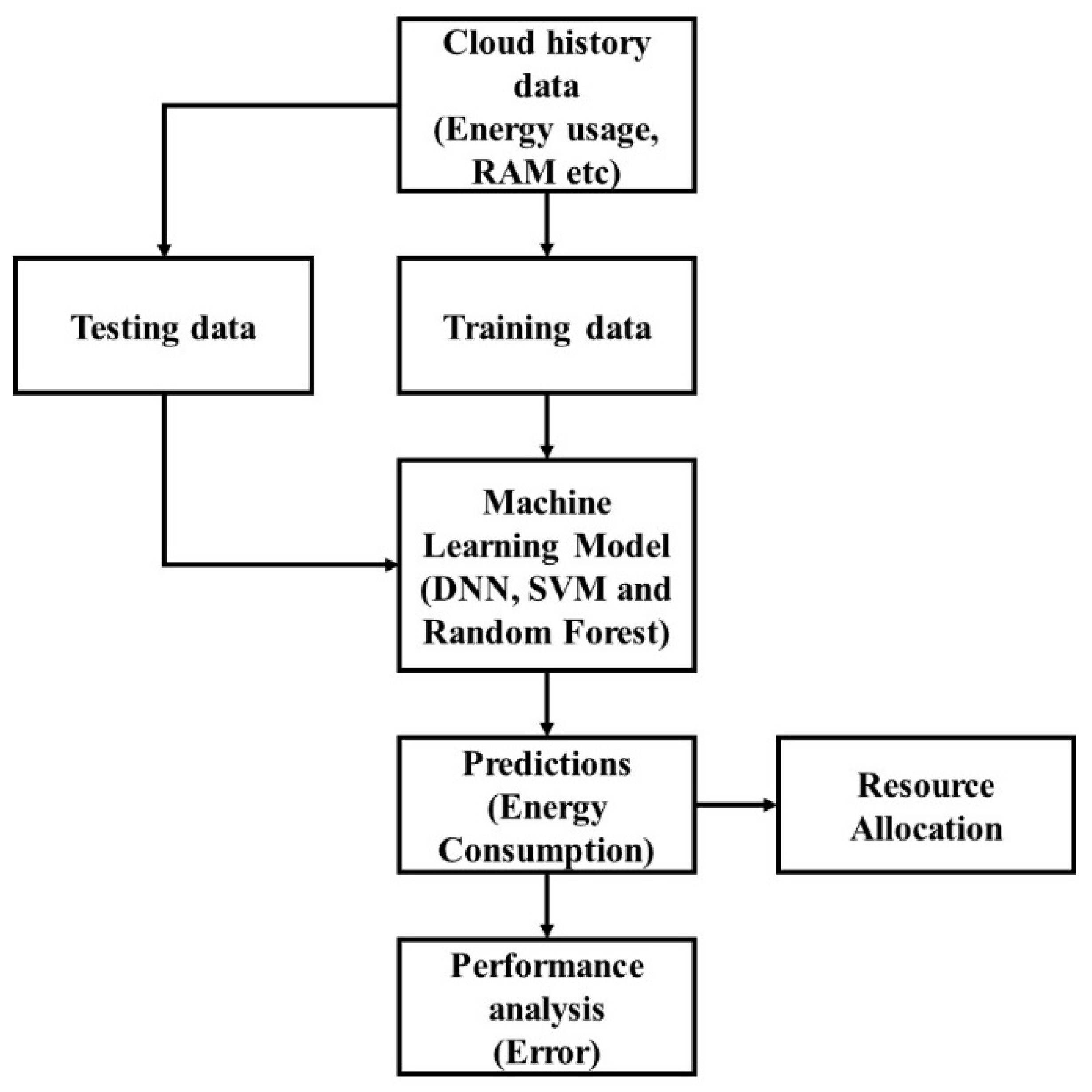
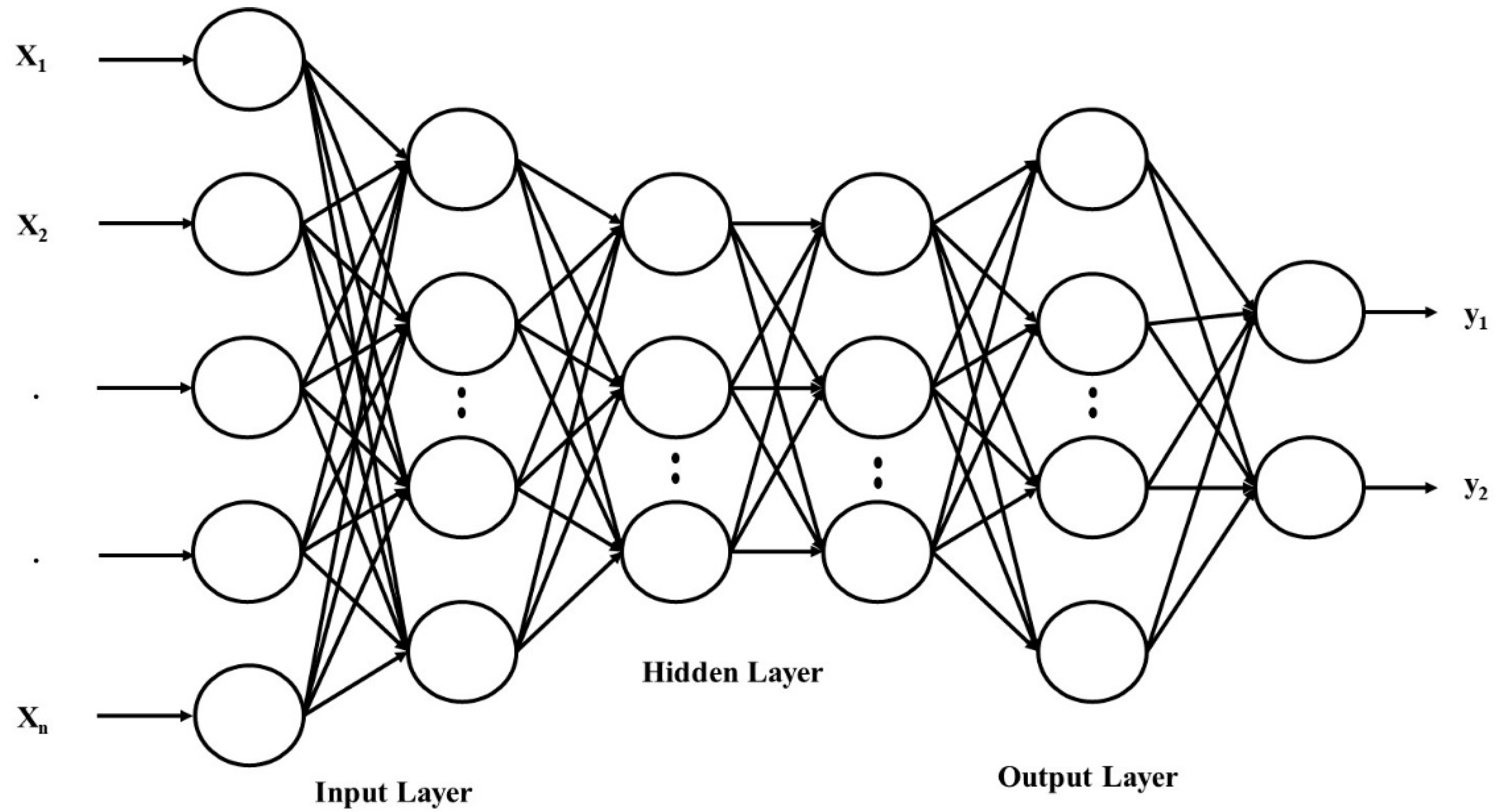
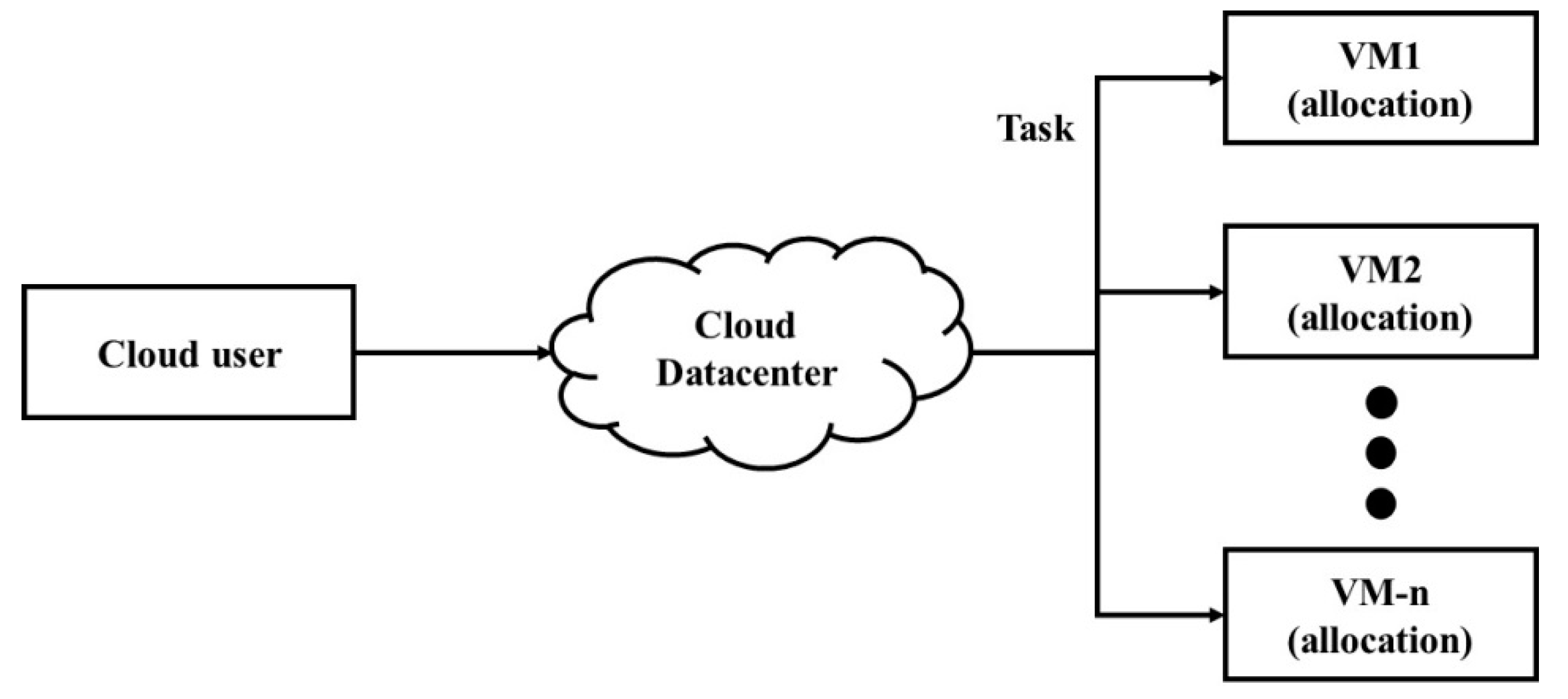
| Study | Energy Management | Cluster Model | Optimization Method | Machine Learning | Summary of Challenges | Future Scope |
|---|---|---|---|---|---|---|
| Daraseliya et al. [41] | √ | - | - | - | √ | - |
| You et al. [42] | √ | √ | √ | - | - | √ |
| Current study | √ | √ | √ | √ | √ | √ |
| Author(s) | Method | Advantages | Limitations |
|---|---|---|---|
| Fard et al. [46] (2017) | This study proposed virtual machine consolidation method to achieve the Quality of Services (QoS)-energy performance in the model. The proposed model was implemented in the CloudSim to test the performance. The QoS and SLA violation were also considered in this model for the analysis. | The result showed that the proposed model had higher performance in terms of energy consumption and QoS. | The model optimization depends on the one parameter solution that affects the performance. |
| Aujla and Kumar [47] (2018) | Energy management with sustainability method was applied in software defined networks (SDN) in the Edge cloud computing. Support vector machine (SVM) was applied for the workload classification in this method. A two-stage method was applied for the workload scheduling and optimal use of network and computer resources. | Resource limited edge devices migrated the users to reduce the Service Level Agreement (SLA) violation in the model. Optimal scheduling of the classifier workloads was done in edge cloud to achieve trade-off between the QoS and energy. | The model requires balanced data to perform effectively in the energy management. |
| Karthikeyan et al. [48] (2020) | Naïve Bayes with hybrid optimization of artificial bee colony–bat algorithm was proposed in this study to reduce energy consumption in Virtual Machine (VM) migration. The proposed method was implemented in CloudSim, which evaluated the success rate, failure rate and energy consumption of the proposed model. | The model showed higher efficiency in the energy management and achieved the higher success rate. The optimization method provided the considerable performance in the VM migration. | The optimization method had lower convergence and was easily trapped into local optima. |
| Yadav et al. [49] (2020) | The gradient descent based regression (Gdr), bandwidth-aware selection policy (Bw), and maximize correlation percentage (MCP) was applied for energy management and SLA violation. The developed method detected the overload host and performed VM selection to reduce the energy consumption and SLA violation. The Bw method dynamically selected the VM based on the network traffic of the host under SLAs. | The analysis showed that the energy consumption was reduced and also performance was increased. The computational time of the developed method was acceptable in the analysis. | The learning rate of the model was low and it was easily trapped into local optima. |
| Lin et al. [50] (2018) | The distributed energy consumption method was proposed for the heterogeneous cloud based on multi-component power model. The mathematical relation of the CPU, disk, and memory was analyzed in this study for energy consumption. The disk power model was applied in this method to provide threshold for the disk sequential and power calculation. | The developed method reduced the energy consumption in the heterogeneous cloud environment. The performance of the cloud service is improved in this method. | The model had lower efficiency in handling the multi-objective optimization. |
| Fernández-Cerero et al. [51] (2018) | This study developed the simulator for the cloud optimization of energy consumption and resources. The parallel scheduling model was developed to reduce the energy consumption for the heterogeneous, realistic and synthetic workloads. | The developed model had higher performance in terms of total energy efficiency, and scheduling process in the cloud. | The workload and QoS constrains were not considered in this model. |
| Chen et al. [52] (2018) | The budget pre-assignment method was proposed for the energy reduction in cloud computing. Three types of directed acyclic graph (DAG) method were applied in the heterogeneous computing system. The proposed method was implemented in the cloud to test its performance. | The developed method had higher energy efficiency. | The QoS and SLA violation were not considered in this method. |
| Li et al. [53] (2019) | The tradeoff strategy was applied in this method for optimal energy consumption and delay threshold in the cloud. The delay threshold was and energy consumption were analyzed for various layers. A cloud-fog scheduling method was proposed for the energy consumption in the model. | The developed method had higher efficiency in energy consumption in various layers of cloud. The developed method provided the considerable delay to reduce the energy consumption. | The solution for the VM migration was not efficient and an evolutionary optimization method was required to provide an effective solution. |
| Xie et al. [54] (2020) | Global energy saving for multiple workloads (GESMW) was proposed in this study for a cyber physical system (CPS). The GESMW method involved meeting the deadline of the workloads to reduce the energy consumption. The various types of workflow was analyzed in this study for effective management. | The GESMW model had shown higher performance in the energy management and met the deadline of workloads. | The GESMW model failed to analyze the physical environment of the CPS for the energy management. |
| Yang et al. [55] (2020) | The game theory task scheduling algorithm was proposed in this study for energy management. The balanced scheduling algorithm was applied for the reliability, and task scheduling model was applied for the computing nodes. The objective function was considered in the equilibrium state. | The game theory method gave a more efficient performance of optimization in terms of energy management. The energy consumption was reduced with considerable QoS. | This study did not consider the processing cost of the network and the processing cost is required for the energy management. |
Publisher’s Note: MDPI stays neutral with regard to jurisdictional claims in published maps and institutional affiliations. |
© 2021 by the authors. Licensee MDPI, Basel, Switzerland. This article is an open access article distributed under the terms and conditions of the Creative Commons Attribution (CC BY) license (https://creativecommons.org/licenses/by/4.0/).
Share and Cite
Jayaprakash, S.; Nagarajan, M.D.; Prado, R.P.d.; Subramanian, S.; Divakarachari, P.B. A Systematic Review of Energy Management Strategies for Resource Allocation in the Cloud: Clustering, Optimization and Machine Learning. Energies 2021, 14, 5322. https://doi.org/10.3390/en14175322
Jayaprakash S, Nagarajan MD, Prado RPd, Subramanian S, Divakarachari PB. A Systematic Review of Energy Management Strategies for Resource Allocation in the Cloud: Clustering, Optimization and Machine Learning. Energies. 2021; 14(17):5322. https://doi.org/10.3390/en14175322
Chicago/Turabian StyleJayaprakash, Stanly, Manikanda Devarajan Nagarajan, Rocío Pérez de Prado, Sugumaran Subramanian, and Parameshachari Bidare Divakarachari. 2021. "A Systematic Review of Energy Management Strategies for Resource Allocation in the Cloud: Clustering, Optimization and Machine Learning" Energies 14, no. 17: 5322. https://doi.org/10.3390/en14175322
APA StyleJayaprakash, S., Nagarajan, M. D., Prado, R. P. d., Subramanian, S., & Divakarachari, P. B. (2021). A Systematic Review of Energy Management Strategies for Resource Allocation in the Cloud: Clustering, Optimization and Machine Learning. Energies, 14(17), 5322. https://doi.org/10.3390/en14175322








